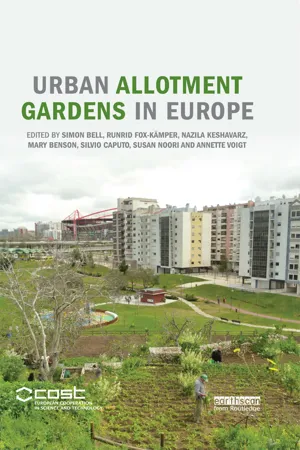
Urban Allotment Gardens in Europe
- 384 pages
- English
- ePUB (mobile friendly)
- Available on iOS & Android
Urban Allotment Gardens in Europe
About this book
Although urban allotment gardening dates back to the nineteenth century, it has recently undergone a renaissance of interest and popularity. This is the result of greater concern over urban greenspace, food security and quality of life. This book presents a comprehensive, research-based overview of the various features, benefits and values associated with urban allotment gardening in Europe.
The book is based on a European COST Action project, which brings together researchers and practitioners from all over Europe for the first detailed exploration of the subject on a continent-wide scale. It assesses the policy, planning and design aspects, as well as the social and ecological benefits of urban allotment gardening. Through an examination of the wide range of different traditions and practices across Europe, it brings together the most recent research to discuss the latest evolutions of urban allotment gardening and to help raise awareness and fill knowledge gaps.
The book provides a multidisciplinary perspective, including insights from horticulture and soil science, ecology, sociology, urban geography, landscape, planning and design. The themes are underpinned by case studies from a number of European countries which supply a wide range of examples to illustrate different key issues.
Frequently asked questions
- Essential is ideal for learners and professionals who enjoy exploring a wide range of subjects. Access the Essential Library with 800,000+ trusted titles and best-sellers across business, personal growth, and the humanities. Includes unlimited reading time and Standard Read Aloud voice.
- Complete: Perfect for advanced learners and researchers needing full, unrestricted access. Unlock 1.4M+ books across hundreds of subjects, including academic and specialized titles. The Complete Plan also includes advanced features like Premium Read Aloud and Research Assistant.
Please note we cannot support devices running on iOS 13 and Android 7 or earlier. Learn more about using the app.
Information
1
A history of urban gardens in Europe
Introduction
| Year | Phase | Key factors affecting urban gardening | Country |
| | |||
| 1700-1910 | Industrialization | • Early provision of land for the poor | Pioneers: Austria, Belgium, Denmark, |
| • City Beautiful Movement | Finland, France, Germany, | ||
| • New towns and suburbs laid out by philanthropic industrialists | Luxembourg, Ireland, Netherlands, Norway, Poland, Sweden, Switzerland, the UK | ||
| 1911-1950 | The world wars and Great Depression | • Allotments as a solution to hunger and unemployment | Pioneers plus Croatia, the Czech Republic, Estonia, Italy, Latvia, Lithuania, |
| • Victory gardens | Spain | ||
| • International allotment movement | |||
| • Allotment clubs and associations | |||
| 1951-1972 | Post-war decline | • Ending of war | Pioneers except former |
| • Post-war urban development | East Germany, Estonia, Latvia, Lithuania | ||
| • Decline of unemployment | |||
| • Advances in living standards | |||
| 1973 the present | The revival of urban gardens | • Increased disconnection between people and nature | Pioneers and newcomers: Cyprus, Greece, Malta, |
| • Rise of the environmental movement | Portugal, Serbia, Spain | ||
| • Neo-traditionalism | |||
| • Sustainable development | |||
| • Globalization | |||
| • Twenty-first century economic depression | |||
The first phase: industrialization (1700–1910)
Table of contents
- Cover
- Half Title
- Title
- Copyright
- Contents
- List of boxes
- Notes on contributors
- Preface
- Foreword
- Introduction
- 1 A history of urban gardens in Europe
- PART I Urban allotment gardens in the European political, planning and legal sphere
- PART II The ecology of urban allotment gardens
- PART III Spatial design aspects of urban allotment gardens
- PART IV The social sphere of urban allotment gardens
- Concluding remarks
- Index